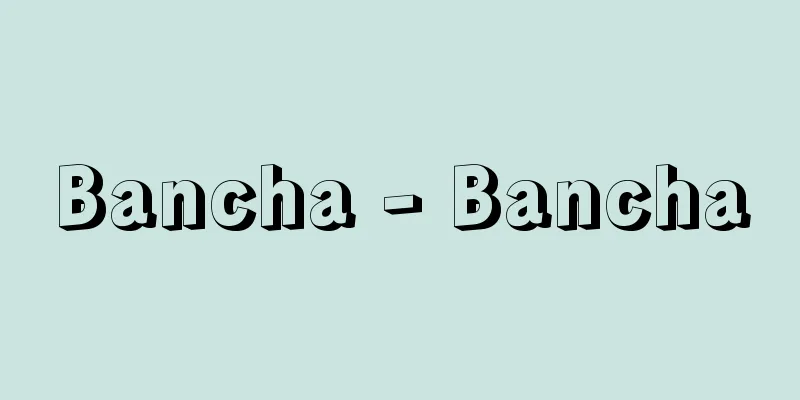Bancha - Bancha

|
Bancha means late-harvested tea, and in the past, the tea leaves were left in the fields until they were fully grown, then they were harvested by cutting with a sickle, straining, roasting or boiling, drying in the sun, and when they were half-dried, they were kneaded and dried further to make the tea. When hand-picking of tea leaves became popular, the raw material was the hardened leaf stalks left over after the tea leaves for sencha were harvested, and after picking with scissors became widespread, the main raw materials became the coarse parts (oatama) and stems that are left over during the sencha manufacturing process. There is also karibancha, which is made from the stalks and hard leaves that are cut to shape the tea fields. Depending on the time of harvest, it is called autumn ban, winter ban, spring ban, etc., but the tea harvested to shape the tea after the first tea harvest is of the highest quality. It is processed using machines designed for sencha. The tea has a slightly strong grassy smell, so it is heated strongly (80-90℃) or roasted to remove the unpleasant smell. It contains little caffeine, tannins, amino acids, and other ingredients, and has a light, non-irritating flavor. For brewing, use 3 grams of tea for one serving, pour in about 130 milliliters of boiling water, and leave to steep for 30 seconds. [Kuwabara Muneta] [Reference] |Source: Shogakukan Encyclopedia Nipponica About Encyclopedia Nipponica Information | Legend |
|
番茶は晩茶、つまり遅くとった茶という意味があり、昔は茶葉が完全に成長するまで畑に置いたものを、鎌(かま)で刈ったり、しごいたりしてとり、炒(い)ったりゆでたりして日干し、半乾きのものをもんで、さらに乾燥してつくっていた。手摘みで煎茶(せんちゃ)がつくられるようになってからは、煎茶用の茶葉をとったあとの硬化葉茎を原料にするようになり、鋏(はさみ)摘みが普及してからは、煎茶の製造過程で出てくる粗大部分(大頭(おおあたま))や茎を主原料とするようになった。また、刈番茶(かりばんちゃ)といって、茶園の形を整えるために刈った木茎、硬葉(こわば)を原料にしたものもある。とる時期により、秋番、冬番、春番などといわれるが、一番茶後の整形のためにとったものがもっとも品質はよい。加工は煎茶用の機械を用いる。香味はやや青臭みが強く、仕上げにあたって強く加熱(80~90℃)したり焙(ほう)じたりして、いやな臭みは除く。浸出されるカフェイン、タンニン、アミノ酸などの成分は少なく、香味は刺激的でなく軽い。いれ方は、1人前の茶の量を3グラムとし、約130ミリリットルの熱湯を注ぎ30秒浸出させる。 [桑原穆夫] [参照項目] |出典 小学館 日本大百科全書(ニッポニカ)日本大百科全書(ニッポニカ)について 情報 | 凡例 |
<<: Panca‐Sila (English spelling)
>>: Pan-chi-wen (English spelling)
Recommend
Kagawa Irrigation Canal
This irrigation canal directs water from Sameura D...
Freedom of Professors
...By its very nature, this freedom cannot be den...
Zachsia zenkewitschi (English spelling) Zachsiazenkewitschi
...The tail plug is long and shaped like a wheat ...
Tomopteris septentrionalis (English spelling) Tomopterisseptentrionalis
… [Minoru Imajima]. … *Some of the terminology th...
Public affairs - lottery
〘 noun 〙 In the Middle Ages, products collected as...
Violence - violence
Generally, in the political world, physical force...
Alaungpaya (English spelling)
[Born] 1714 [Died] 1760. Founder of the Konbaung d...
Inn [river] - Inn
It originates in a lake in the Bernina Alps in Swi...
The language of carnival
...This "dialogical positioning" of lan...
Parasilurus asolus (English spelling) Parasilurusasolus
...A species of freshwater fish in the Siluriform...
Choreometrics
…Effort Shape can describe the dynamics of a move...
Blueprint - Aojashin
A type of copying method that uses chemically sen...
Chirigumo - Chirigumo
This spider belongs to the Arthropoda phylum, Ara...
chin
… [Chin] It is the part that protrudes from the c...
Tourist city - Kankoushi
A city rich in cultural assets, historical sites,...



![Tomioka [town] - Tomioka](/upload/images/67cc5aedd7757.webp)





